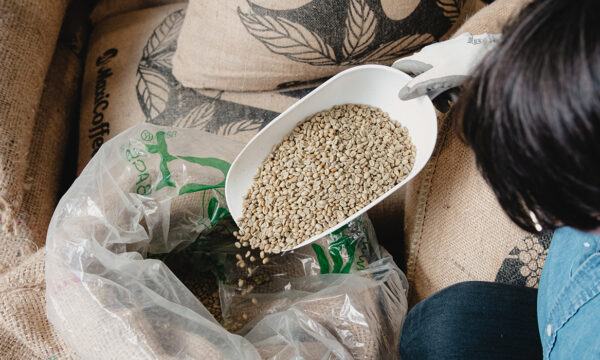
Coffee processing: New experimental processes for green coffees

Written by Julie
Reading time 7 minDoes coffee have an acidic taste? When we talk about making a well-balanced coffee, we essentially mean finding harmony between the different flavours: sweetness, bitterness and acidity. The latter is often mistakenly considered to be a defect, since we’re more used to coffees that are roasted longer and therefore taste more bitter. However, coffee acidity can contribute to a more complex profile, adding clarity and beautiful floral and fruity notes to your drink.
To start with, we should be talking about acidities rather than acidity, as each type of acidity contributes its own unique characteristics to your favourite drink. The list is long and varied, so let’s focus on the three best known.
Often associated with lemons, the citrus notes commonly found in Ethiopian coffee and Geisha coffee are all to do with the presence of citric acid. But contrary to what you might think, the presence of this acid itself is actually linked to sugar!
Malic acid is sometimes associated with green apples. It gives you a fresh sensation in your mouth! Malic acid can be found in Kenyan coffees, among others.
This acid is extremely sweet, highlighting the sugary qualities of the coffee. Lactic acid can encourage flavour notes such as yoghurt or fresh butter… which can be somewhat surprising in a coffee! This phenomenon results from the beans undergoing a process of anaerobic or malolactic fermentation.
Find out more: Acetic acid is also sometimes present in coffee. However, this is less common as it is mainly produced as a result of experimental fermentations.
Did you know? When Q Graders score a coffee, they do not rate it on its bitterness but on its acidity and sweetness. A high score denotes an “expressive” coffee with a complex aromatic profile. But watch out, because “expressive” means that it will not be to everyone’s tastes! These coffees often have a very striking flavour, a far cry from the taste of standard everyday coffee.
Acidic, bitter and sweet flavours are all naturally present in the coffee cherry. A base level of acidity is established when the coffee is grown, but it can then be altered at every subsequent step to ensure the desired aromatic profile.
There are several variables that can produce an acidic taste in the coffee grown at different plantations:
As you will have gathered, the conditions in which the coffee plants are grown have a major impact on the degree of acidity found in the cherry. If the coffee has been well grown, acidity and sweetness will be the dominant tasting notes.
The choice of processing method is another factor that has a big impact on coffee acidity. It is this step that defines the profile of the green coffee. Most of the sweetness of the coffee cherry is found in its pulp. The longer the coffee ferments with the pulp left on, the more interaction there is between the pulp and the bean. For natural coffees, the beans are left fully intact as they ferment and dry, resulting in greater sweetness. For traditional washed coffees, the pulp is removed at the start, developing the level of acidity. However, great care must be taken to avoid over-fermentation, which can cause an unbalanced flavour by masking the acidity and introducing parasitic notes (even including the taste of onion, in particularly extreme cases).
A closer look at fermentation: Just like grapes in winemaking, coffee cherries also need to undergo the process of fermentation. In general, fermentation takes place owing to the natural yeasts and bacteria found on the skin of the cherry. The presence of yeast contributes to transforming the sugar into another molecule (lactic or malic acid, for example). Coffee farmers can use different fermentation conditions – i.e. their choice of processing method (natural, washed, honey, anaerobic) – to encourage the development of more or less acidity in the resulting coffee.
When they receive their batches of green coffee, roasters are able to make certain choices in order to enhance – or reduce – the coffee acidity. Remember, the longer the coffee beans are roasted, the less pronounced the characteristics associated with their terroir will become. The coffee will take on a roasted taste, i.e. notes of toast, hazelnut, etc. As we have already seen, good coffee naturally contains a certain level of acidity. Particularly in the case of speciality coffee, the main aim of the roasting process is to showcase the terroir of the coffee, to let it express itself. The floral and fruity notes found in light or very light roasts are created by the acidity of the coffee. Acidity is still present in medium roast coffee, but it is offset by the sweetness resulting from the longer roasting time.
It is important to know that even the smallest decision relating to the extraction of your coffee will affect the way it tastes. In other words, the flavour of your coffee will depend on how you make it. There are many variables that can affect coffee acidity:
It is generally recommended to extract coffee at between 88°C and 96°C. This temperature should be adjusted according to the roast profile of your coffee and your own taste preferences. The darker the roast, the cooler the water should be (although it should always remain within the recommended temperature range).
* Of course, this is just a guideline! The only limit to coffee is your imagination.
Did you know? Acidity tends to be obtained using the milder extraction methods that produce a less aggressive flavour than, for example, an espresso. In fact, acidity in an espresso is often mistaken for sourness, even though a successfully extracted espresso can be a genuinely vibrant and refreshing drink.
To sum up, coffee acidity is – contrary to popular belief – a very good thing! It may be easier to achieve this flavour using milder extraction methods, but it is by no means a defect in an espresso. Acidity adds a touch of freshness and balance to your coffee. And as we always say, the most important thing in an extraction is the harmony of the flavours! Over to you!
Discover all of our articles